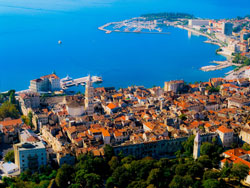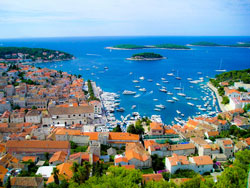|
| Bukara Tours |
|
| Our goal is to improve the tourist content of Drvenik and to provide memorable experiences for each of our guests. We organize field trips to Dubrovnik, Split, Međugorje, the Baćina lakes and Mostar. These destinations are famous for their cultural and natural heritage. We also organize boat trips to Hvar and Korčula, with lunch included. You can participate in fishing, in the company of good sport fishermen, and experience the sunset on the sea in a unique way. |
| To complete the tourist content, we offer all of our guests the opportunity to plant an olive tree. As part of our ancestors' crafts in planting dalmatian flora, we wish for our visitors to have a pleasant experience in the true spirit of this area. Naturally, the fruits of the planted olives will be processed and turned into olive oil. The guest who planted the olive tree will have the opportunity to taste it's olive oil in the Dalmatian specialties which we offer in our restaurant.
|
| We also organize tours through wine routes, field trips to the peak of Biokovo (St. Jure) and visits to the ethnic village Kokorići, near Vrgorac. We have access to an air conditioned minibus and offer exchange services, as well as parking. For all other wishes, please feel free to ask, and we will give our best effort to make your wish a reality. |
 |
Baćina Lakes |
The Baćina lakes is a series of interconnected fresh water karst lakes, 1.5 km north of Ploče. The lakes are surrounded by meadows and poplar trees, and along the low acessible coastlines there are small beaches and picturesque groups of reeds and other aquatic plants. The surface of the lakes is above the sea level, while the bottom is below, with the maximum depth of 28m. The water flows from the lakes into the Ploče bay via a tunnel, which was dug in 1911. - 1912. The main road (M2) passes along the west and south sides of the lakes. |
| Back to top |
| Split |
 |
| Split is not only the leading urban, cultural and traffic center of Dalmatia, which is connected by land and sea routes with numerous summer resorts throughout Dalmatia, but is by itself a frequent tourist destination. The city with its 1700 years of existence along with its many archeological, historical and cultural monuments, among which the most noteworthy is the famous Diocletian's palace, is one of UNESCO's world heritage sites. The first detailed guide of Split and its surroundings, published in 1984., speaks of the city's long tourist tradition. |
| Because of the copious history of the city, one should visit its museums: The museum of Croatian archeological monuments - a capital project of Croatian culture established in 1983. in Knin; The Archeological museum from 1920. - one of the oldest museums in Croatia; The treasury of the Split cathedral - which holds a valuable collection of religious arts; The Ethnographical museum - established in 1910.; The museum of maritime history; The museum of natural science. There are other places worth visiting, such as the arts gallery - established in 1931., the collection of the Franciscan monastery in Poljud, the Meštrović gallery and others. |
| Back to top |
 |
Dubrovnik |
| Dubrovnik is a city of unique cultural and political history (the republic of Dubrovnik, the city statute from 1272.), of world famous cultural heritage and beauty (one of UNESCO world heritage sites) and is one of the most beautiful and famous Mediterranean cities. With exceptional natural beauty and the preservation of its heritage, Dubrovnik is a city of a very rich tourist offer. It is a city of hotels, beautiful surroundings, a very impressive ecological standard and is attractive throughout the whole year. Its geographical isolation is compensated by high traffic standards, especially air traffic and the fast hydrofoil ships. |
| The development of tourism in Dubrovnik started before world war 1, and it grew fast into a very famous international tourist destination. The museum of Dubrovnik in the Duke's palace has more than 15000 objects in its culture - history department. There is a collection of furniture from 17th - 19th century, of dukes' and councilors' vestments and nobles' attires in the authentic halls of the palace. The maritime museum (located in the Sveti Ivan fortress) has a permanent exhibition of various things from Croatian maritime history, with a special emphasis on the history of the republic of Dubrovnik. The museum of the Franciscan monastery holds the entire inventory of the old pharmacy as well as the works of the old goldsmiths, painters and embroiders workshops. The museum of the Dominican monastery holds valuable paintings from 15th and 16th century, sculptures, goldsmith's works, manuscripts, incunabula and notes. The treasury of the Dubrovnik cathedral holds st. Blaise's relics, as he is the patron saint of Dubrovnik, as well as many other paintings and valuable objects. The Rupe Ethnographical Museum presents traditional enterprises and the rural architecture of the region of Dubrovnik, as well as national costumes and handmade textiles. Among the other attractions is the aquarium of the Biological institute, located in the Sveti Ivan fortress, which houses many interesting marine species. |
| Back to top |
| Hvar |
 |
| Hvar is a small town of exceptional cultural - historical legacy, as well as a strong tourist destination with a century long tradition. Pleasant climate, natural beauties, many kind of tourist and catering objects and sports - recreational offers attract visitors during summer as well as in winter. Climate characteristics made medical tourism possible to develop. Long time ago, in 1868, the Hygiene society was founded in Hvar. It took care of the foreign visitors' pleasant stay in town. That's, in fact, how modern tourism started to develop. |
| The first hotel in Hvar, "Carica Elizabeta" ("Empress Elizabeth"), was opened in 1903. Hvar has outstanding cultural heritage - the cathedral, the Franciscan monastery, the Hvar theatre, forts with breathtaking views of Pakleni Islands and Vis Island, as well as a variety of high quality accommodation - hotels, apartments, pensions, camps. There are many sports and recreational choices as well - tennis, table tennis, basketball, bowling, and various water-sports rentals. |
| Back to top |
 |
Korčula |
| Korčula, the center of the island's history, located in the Pelješac Channel, is well-known for the richness of its cultural and historical heritage, as well as its maritime, shipbuilding and stonemasons traditions. It is the birthplace of the famous seafaring explorer Marco Polo. Today, Korčula is a famous tourist destination. The island has a long tradition in tourism. The first modern hotel "Korčula" was opened in 1912., in a building that was built in 1871. The hotel's guests have been enjoying sunsets from its terrace for decades, which is an extraordinary experience in early summer. |
| Korčula has a variety of accommodation - hotels, apartments, auto camps, a marina, as well as many sports and recreational choices, especially water sports. Korčula has many tennis courts, places to rent windsurfing boards and other surfing equipment. One can go sailing or yachting, as well as on organized diving trips accompanied by professional divers. There are organized field trips, as well as many cultural and entertainment options, among which the "Moreška" and "Kumpanija" cultural events have become world-famous. Besides the variety of seafood specialties, the variety of exquisite local wines (pošip, rukatac, grk, plavac) is why Korčula is also known as "the island of wine". The local cuisine is also famous for its traditional cakes and sweets, such as "cukarini", "kroštule" and "prikle". |
| Back to top |
|
|









